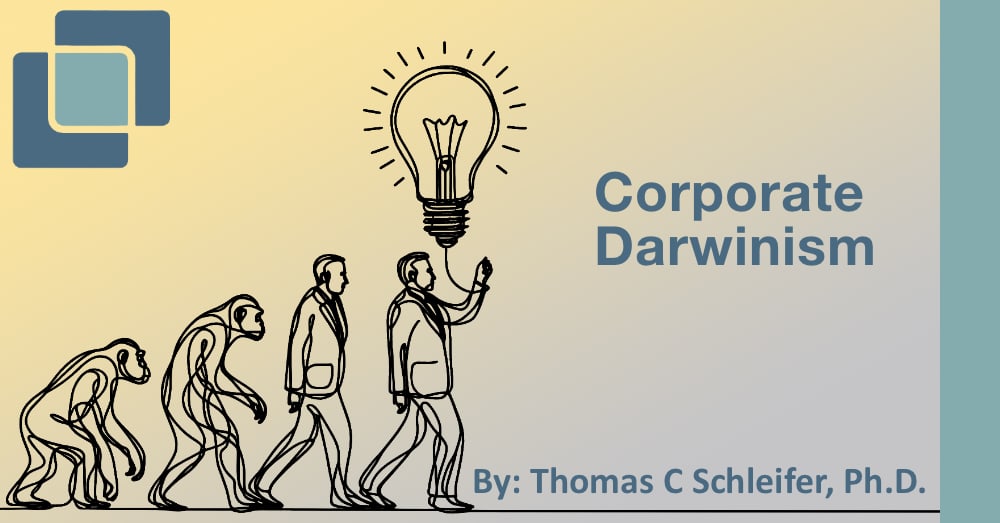
The term “Corporate Darwinism” was the title of a business book published in 1966 that tracked the stages of birth, growth, and death of the typical American industrial corporation. According to the research, all start-ups that survive pass through these five evolutionary stages:
- Existence – start-up – founder wears all hats.
- Survival – break even – positive cash flow – family and friends join the effort.
- Success – Stable profitability – moderate growth – “go/no-go” explosive growth decision.
- Take-off – Fast growth – financing required – public stockholders invited – professional management takes over.
- Resource maturity – financial freedom – market control – predictable outcomes – stability and endurance.
This natural evolution of business enterprises became widely known as “Corporate Darwinism”.
Construction Darwinism
Most construction concerns are born and grow through the first three evolutionary phases like all other industrial companies. Where our industry diverges from the model is at phases four (Take-off) and five (Resource maturity). Few construction concerns are owned by public shareholders or turn the reins over to professional managers. There are five main reasons for this anomaly.
- Construction companies provide “construction services”. They do not manufacture or sell finished goods that garner dependable market share through reputation.
- Construction company founders are hands-on managers who are reluctant to give up any control or ownership of the company they founded to “strangers”.
- Underwriters cannot ascertain a contractor’s revenue base with any degree of certainty since the nature of the business is to migrate from contract to contract. In other words, construction companies have no established revenue foundation on which to build a business.
- Earnings vary from contract to contract, so it is difficult, if not impossible, to value a construction company’s future earning potential.
- Traditionally, construction is a family or closely held business. Founders like to pass the baton to their children or other close relatives.
If construction companies could stabilize in phase three (Success) this resistance to further evolution would present no problem. But, according to Harvard research, corporate Darwinian evolution is an irresistible urge. Construction companies are no exception. Once they have achieved “success” they continue to pursue more growth. However, construction companies resist selling part ownership to public shareholders to raise the capital required to finance “take-off” growth and abhor turning control over to the professional managers needed to run complex corporations.
Crashing on Take-off
For many years I have been warning contractors about the dangers of growing too fast. Few have heeded my cautions because, as the Harvard research points out, the impulse to grow after achieving “success” is an irresistible evolutionary process. The unique risks for construction companies to grow rapidly during the “take-off” phase of corporate evolution is that they resist acquiring the professional management and capital capacity required to make it to “resource maturity”.
Management Capacity
As we have so often discussed in the past, most construction CEOs start out as engineers, construction school graduates, or tradesmen/women working with the tools. If they are naturally endowed with leadership qualities, they usually begin to build a construction company. If the company remains the size and type that a talented “constructor” can run intuitively, they continue to succeed. However, as a company slips past the “success” phase and enters the “take-off” phase it ceases to be simply a “construction” company and becomes a complex corporate entity that requires professional managers schooled in the business aspects of organizational development, corporate finance, strategic planning, and legal compliance to guide it through continuous growth.
Capital Capacity
The main reason so many successful contractors suddenly fail and go out of business is because they lacked the capital to finance the growth they pursued and didn’t realize it. No corporation, construction or otherwise, can finance continuing or rapid growth with internally generated capital. Privately held corporations rarely retain the earnings required to adequately finance big leaps in external growth. Banks will only provide capital based on the corporate and personal net worth of the owner and that’s never adequate. Only abundant external capital is adequate to finance continuous growth.
Decision to Grow
For all the years that I have been advising contractors against growing too fast, I rarely thought of the impulse to grow as a natural byproduct of corporate Darwinian evolution. The more success we experience, the more we are inclined to continue to grow our business. Remember, however, that the decision to grow always depends on your firm’s capacity to manage a large, complex corporate business and to finance growth.
Next week we will talk about how to overcome the resistance to turn control over to professional managers, and the following week we will talk about the acquisition of adequate growth capital.
To receive the free Weekly Construction Messages, ask questions, or make comments contact me at research@simplarfoundation.org.
For a deeper look into business development, read more here: DEVELOPMENT
For a broader view into managing growth, read more here: GROWTH
Please circulate this widely. It will benefit your constituents. This research is continuous and includes new information weekly as it becomes available. Thank you.


